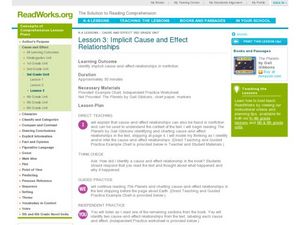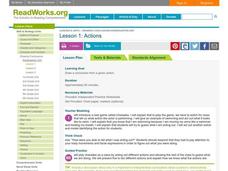Curated OER
Implicit Cause and Effect Relationships
Cause and effect relationships can be found in both fiction and non-fiction texts. As they read the book, The Planets by Gail Gibbons, learners keep an eye out for cause and effect relationships. They chart all of the causes and effects...
Curated OER
Using Evidence to Describe a Character
It's all about the details found in the text, when children attempt to describe the main character from the story, Burnt Toast on Davenport Street. They first discuss the process by which one would go about using textual evidence and...
Curated OER
Realistic Fiction
Explore the characteristics of realistic fiction by reading and then analyzing the book, Allie’s Basketball Dream by Barbara E. Barber. Using the I do, we do, you do model, learners practice identifying realistic fiction based on how...
Curated OER
Main and Secondary Characters
Identify main and secondary characters from a fiction story. Kindergartners do a picture walk with the teacher, and then do the identifying on their own with another book. A good assignment for groups or a whole class to complete.
Curated OER
Actions
Students pair up and one of the students acts out an action while the other draws conclusions from their actions by drawing a picture of what they are doing. In this actions lesson plan, students play charades and guess what each other...
Curated OER
Pictures and Photographs
Students write the facts that they learned from the photographs in the book All About Cats and Kittens. In this pictures and photographs lesson plan, students present their fact to the class and add it to the chart.
Curated OER
Historical Fiction
Students discover how to identify historical fiction. In this historical fiction lesson, students read the story Meet Addy: An American Girl by Connie Porter. Students listen to the first chapter of the book read aloud. Students list...
Curated OER
Red Herrings
Sixth graders make predictions while reading The Westing Game. In this prediction and mystery instructional activity, 6th graders identify red herrings while reading and compare those clues with their predictions. Students complete a...
Curated OER
Explicit Information versus Drawing Conclusions
Third graders identify explicit information and draw conclusions from text. In this instructional lesson, 3rd graders review models of each question type (explicit and conclusion) and practice reading a passage to answer questions.










